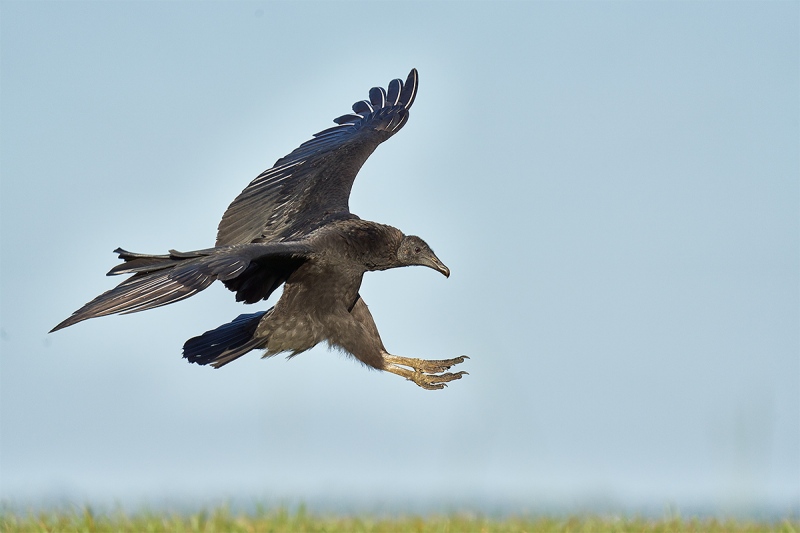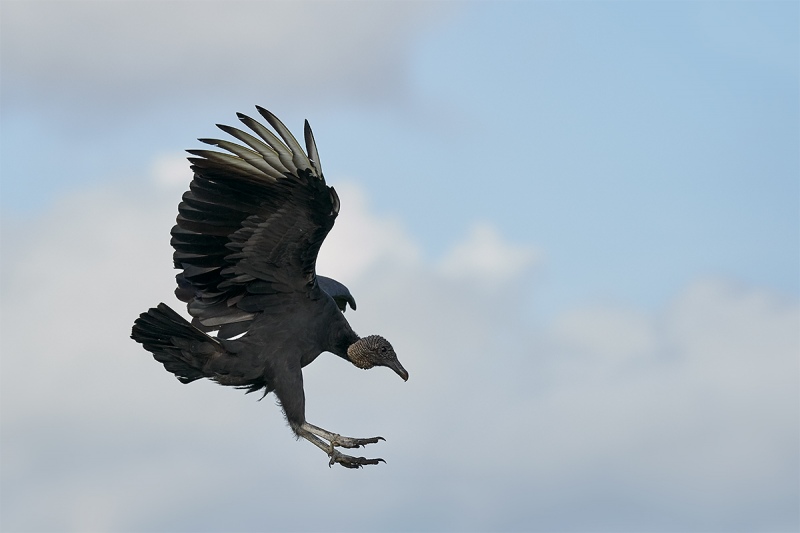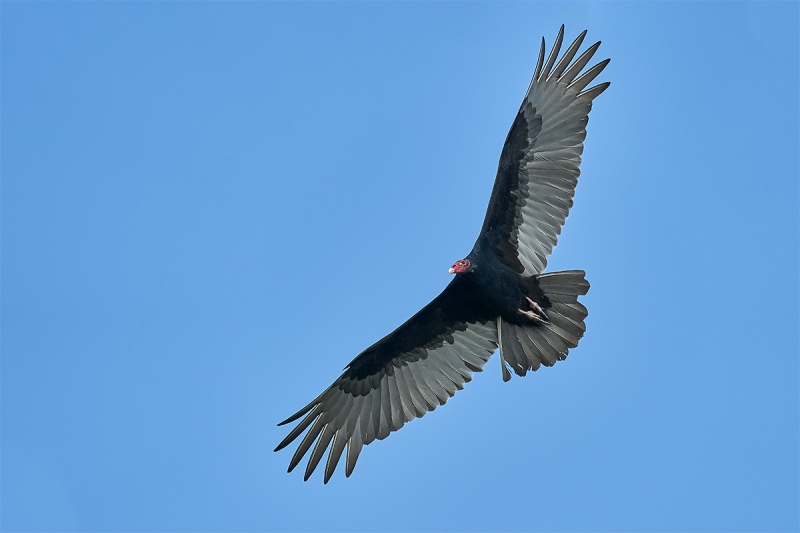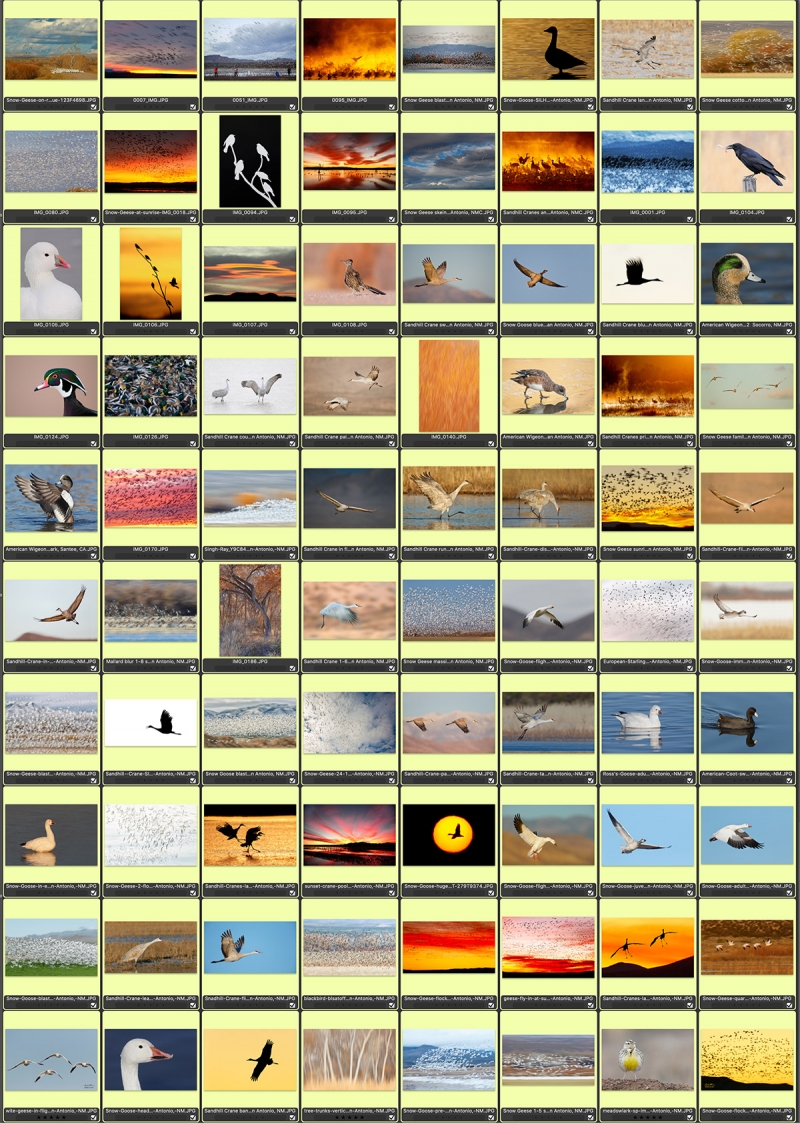What’s Up?
I’ve been down by the lake most every morning photographing the plentiful Black and Turkey Vultures, some days flight, some days 1200mm head portraits, and some days both. I have been so excited by my experience with the Ospreys at Sebastian Inlet that I am staying over on Friday night and will be there all day on Saturday; care to join me?
Speaking of which, nobody came up with the answer to the high-level exposure question in the Osprey Flying Circus blog post here. Only Guido Bee tried. Read my repsonse to his comment for a good clue and then post the correct answer.
Sebastian Inlet In-the-Field Sessions
If you would like to set up a Sebastian Inlet In-the-Field Session, please contact me via e-mail. Morning sessions will run from 7:30 until at least 9:30am. Afternoon sessions will be three hours with the start time determined by the wind and sky conditions. Cheap: $200 per session; do the full day for $350. Add $75 to any morning session for lunch in Vero Beach and an image review session. The weather is looking excellent for this coming Saturday. My schedule for the next two weeks is quite open so it is likely that I can fit my schedule to your needs. Lastly, if you live not-to-far away scheduling can be weather dependent.
Need System or Upgrade Advice?
These are certainly exciting and volatile times in bird and nature photography: Canon, Nikon, SONY? Upgrade or switch systems? Yikes! If you are thinking about switching or upgrading and have questions, feel free to call me on my cell at 863-221-2372 for a free ten-minute consultation. The only thing that I ask in return is that you make a firm commitment to use my B&H affiliate links or to buy from Bedford using the BIRDSASART discount code at checkout if you decide to go forward. Remember that Steve Elkins at Bedford can save you a few additional bucks on lens/camera/accessories packages. See the blog for his contact details. Either way, it will not cost you one penny more.
Be sure to leave a message if I do not pick up and I will get back to you. And please follow that up with an e-mail or a text stating your name and a good time for me to call you back. I spend lots of time each day walking, swimming, and watching football and baseball 🙂 And napping.
IPT Updates
- The Return to Bosque Reduced Rate Scouting IPT. NOV 26-28, 2019 — 3 FULL DAYS: $1199.00. Limit: 8/Openings: 6. Extra Day Options: Join me for one to three extra In-the-Field Days at the end of the IPT as follows: FRI 29 NOV, SAT 30 NOV, and SUN 1 DEC for only $300.00/day.
- The 2020 San Diego 4 1/2-DAY BIRDS AS ART Instructional Photo-Tour (IPT) WED JAN 8, 2020 thru and including the morning session on SUN JAN 12: 4 1/2 days: $2099.(Limit: 8/Openings: 5)
BIRDS AS ART
BIRDS AS ART is registered in the U.S. Patent and Trademark Office.
Money Saving Reminder
If you need a hot photo item that is out of stock at B&H, would enjoy free overnight shipping, and would like a $50 discount on your first purchase over $1000.00, click here to order and enter the coupon code BIRDSASART at checkout. If you are looking to strike a deal on Canon or Nikon gear (including the big telephotos) or on a multiple item order, contact Steve Elkins via e-mail or on his cell at (479) 381-2592 (Eastern time) and be sure to mention your BIRDSASART coupon code and use it for your online order. Steve has been great at getting folks the hot items that are out of stock at B&H. Those include the SONY a7r IV, the SONY 200-600, the SONY 600mm f/4 GM, and the Nikon 500mm PF. Steve is eager to please.


Gear Questions and Advice
Too many folks attending BAA IPTs and dozens of photographers whom I see in the field and on BPN, are–out of ignorance–using the wrong gear especially when it comes to tripods and more especially, tripod heads… Please know that I am always glad to answer your gear questions via e-mail. Those questions might deal with systems, camera bodies, accessories, and/or lens choices and decisions.
|
|
|
This image was created on October 14,2019 down by the lake near my home at Indian Lake Estates. I used the handheld Sony FE 200-600mm f/5.6-6.3 G OSS lens (at 600mm) and the the 61-MP monster, the Sony Alpha a7R IV Mirrorless Digital Camera Body. ISO 1000. Exposure determined by Zebras with ISO on the rear dial: 1/2500 sec. at f/7.1 in Manual mode. AWB at 8:43am on a sunny morning. Center Zone Continuous/tracking AF was active at the moment of exposure. Click on the image to enlarge and see the rather poor image quality and sharpness. Image #1: Black Vulture coming in to land |
200-600 Flight with the a7r IV
After having success on flying birds with the a7r III and the 100-400 in the Galapagos, and then again at DeSoto with the a7r IV and the 600 GM both with and without the 1.4X teleconverter, flight images made with the 200-600/a7r IV combo have not been as sharp consistently as I had expected. Please note that this observation is based on a very small sample size. At this point, I am simply not sure of the cause. Others have reported great success shooting flight with the 200-600/a7r IV rig. Heck, maybe it is operator error.
Image #1 above is a perfect example. The RAW file was not very sharp. During the conversion of the AWR file in Capture One, I tried to save the image with healthy moves to the right with both the Clarity and Structure sliders. (This approach is far less than ideal, but I loved the pose and the tiny strip of grass at the bottom.) In Photoshop I applied my NIK 30-30 recipe to the bird and added a contrast mask to the vulture’s face. Again, you can click on the image to enlarge it and see the rather poor image quality and sharpness.
I am looking forward to getting to Bosque and having lots of chances to do flight photography with all of my SONY bodies and lenses (in varying combinations).
If you have a great flight image created with the 2-6/a7r IV please send me a 1200 wide JPEG via e-mail.
|
|
|
This image was created on October 25, 2019 down by the lake near my home at Indian Lake Estates. I used the handheld Sony FE 200-600mm f/5.6-6.3 G OSS lens (at 289mm) and the AF King, the Sony Alpha a9 Mirrorless Digital camera body. ISO 2000. Exposure determined by Zebras with ISO on the rear dial: 1/2500 sec. at f/7.1 in Manual mode. AWB at 8:44am on a cloudy-bright morning. Center Zone Continuous/tracking AF was active at the moment of exposure. Image #2: Black Vulture braking to land |
200-600 Flight with the a9
Today, if my life depended on making a single sharp flight image with my SONY 200-600, the a9 would be my camera-of-choice. With birds angling towards or flying right at me, Center Zone AF performs superbly. Whether you are using Center Zone or Wide, it is important to frame the image so as to keep the flashing AF points on the bird’s head. This is not as easy to do as it might seem. The stronger and more fit you are, the more successful you will be.
The tradeoff here is that image quality and fine feather detail with the a9 are not as good as with either the a7r III or the a7r IV.
Vultures in Flight Ain’t Easy
Though both Black and Turkey Vultures are large, slow-flying birds, they are not easy to photograph in flight. Here’s why:
- 1- With predominately black plumages, you need to use relatively high ISOs as compared to when you are working with gulls or terns or white egrets or white geese.
- 2- Black Vultures offer little contrast about the head making things tough for autofocus.
- 3- Both species show some white or silver feathers when photographed from below. This makes it mandatory to have a flat flight pose with the underparts evenly lit. See Image #3 for a perfect example of what that looks like when done well.
- 4- In full sun, getting the exposure right is very difficult and the importance of having the subject evenly lit cannot be overstated.
Note: because of their highly sociable and gregarious behavior, Black Vultures are often splattered with whitewash.
|
|
|
This image was also created on October 25, 2019 down by the lake near my home at Indian Lake Estates. Again I used the handheld Sony FE 200-600mm f/5.6-6.3 G OSS lens (at 489mm) and the AF King, the Sony Alpha a9 Mirrorless Digital camera body. ISO 3200. Exposure determined by Zebras with ISO on the rear dial: 1/2500 sec. at f/7.1 in Manual mode. AWB at 7:23am on a cloudy-bright morning. Center Zone Continuous/tracking AF was active at the moment of exposure. Image #3: Turkey Vulture soaring |
Advantages and Disadvantages of the SONY 200-600 for Flight
Pluses
- 1- At 600mm, it offers great reach for a lens that is hand-holdable for most folks.
- 2- It is a zoom lens so when the birds get close you can zoom out to better fit the bird in the frame. See images 2 & 3 above.
- 3- It is nicely balanced with much of the weight toward the rear of the lens.
- 4- At $1998, it is a lot less costly than a 600 GM. Value-wise, it is a steal.
Minuses
- 1- The 200-600 is a bit too heavy for some folks to handhold.
- 2- With a variable aperture of f/5.6-6.3, the 2-6 is relatively slow. As I like to stop down one-third stop rather than shooting wide open, that puts me at f/7.1; when I need lots of shutter speed, I need to use higher ISOs. Note the relatively high ISOs used to create today’s featured images …
- 3-The jury is still out on AF tracking accuracy with the a7r IV, at least for me …
|
|
Bosque del Apache 2019 IPTNotice the incredible variety of images that you can learn to make by developing your skills and your creative vision on a BAA IPT. |
2019 Bosque del Apache IPT
Return to Bosque Reduced Rate Scouting IPT #1. NOV 26-28, 2019 — 3 FULL DAYS: $1199.00. Limit: 8/Openings: 6. Introductory Meet and greet at 7pm on MON 25 NOV.
Extra Day Options: Join me for one to three In-the-Field Days as follows: FRI 29 NOV, SAT 30 NOV, and SUN 1 DEC for only $300.00/day.
I quit going to Bosque several years ago as conditions had worsened each year for several seasons running. My understanding is that things have improved dramatically in recent years. Photography-wise, I know Bosque better than anyone. Join me to learn how wind and sky conditions influence bird photography, how to create dramatic sunrise and sunset silhouettes, how to be in the right place at the right time, and how to create contest-winning blurs. As usual, you will learn to get the right exposure every time, to use your camera’s AF system to create pleasing, balanced image designs, and to improve your flight photography skills.
We should get to photograph many thousands of Snow Geese, more than a few blast-offs, some Ross’s Geese, and lots of Sandhill Cranes in the water, taking flight and flying. Depending on local conditions we may get to shoot some ducks: point-blank American Wigeon and Wood Duck. With any luck, we might enjoy sunrises and sunsets that leave you in tears. Live, eat, and breathe photography with one of (if not the) world’s premier photographic educators at one of his very favorite locations on the planet. Top-notch Photoshop instruction. Join me to learn to think like a pro and to recognize situations and to anticipate them based on the weather. Every time we make a move, I will let you know why. When you get home, applying what you learned will prove to be invaluable.
Lunch is included.
To Register
To register, send your non-refundable $500 deposit — check made out to BIRDS AS ART — via US Mail to PO Box 7245, Indian Lake Estates, FL 33855. Or call Jim weekdays at 863-692-0906 to put your non-refundable deposit on a credit card. Balances must be paid in full by check no later than two months before the IPT. If you cancel, all but your deposit will be refunded only if the IPT sells out.
Travel Insurance
Travel insurance for both big international trips and US-based IPTs is highly recommended as we never know what life has in store for us. I strongly recommend that you purchase quality travel insurance. Travel Insurance Services offers a variety of plans and options. Included with the Elite Option or available as an upgrade to the Basic & Plus Options you can also purchase Cancel for Any Reason Coverage that expands the list of reasons for your canceling to include things such as sudden work or family obligation and even a simple change of mind. My family and I use and depend on the great policies offered by TIS whenever we travel. You can learn more here: Travel Insurance Services. Do note that many plans require that you purchase your travel insurance within 14 days of our cashing your deposit check or running your credit card. Whenever purchasing travel insurance, be sure to read the fine print carefully even when dealing with reputable firms like TSI.
If In Doubt …
If you are in doubt about using the BAA B&H affiliate link correctly, you can always start your search by clicking here. Please note that the tracking is invisible. Web orders only. Please, however, remember to shoot me your receipt via e-mail.


Please Remember to use my Affiliate Links and to Visit the BAA Online Store 🙂
To show your appreciation for my continuing efforts here, we ask, as always, that you get in the habit of using my B&H affiliate links on the right side of the blog or Bedfords, for all of your photo and electronics purchases. Please check the availability of all photographic accessories in the New BIRDS AS ART Online Store, especially the Mongoose M3.6 tripod head, Wimberley lens plates, Delkin flash cards and accessories, and LensCoat stuff.
As always, we sell only what I have used, have tested, and can depend on. We will not sell you junk. We know what you need to make creating great images easy and fun. And please remember that I am always glad to answer your gear questions via e-mail.
I would, of course, appreciate your using our B&H affiliate links or Bedfords for all of your major gear, video, and electronic purchases. For the photographic stuff mentioned in the paragraph above, and for everything else in the new store, we, meaning BAA, would of course greatly appreciate your business. Here is a huge thank you to the many who have been using our links on a regular basis and those who will be visiting the New BIRDS AS ART Online Store as well.
Be sure to like and follow BAA on Facebook by clicking on the logo link upper right.
Typos
In all blog posts and Bulletins, feel free to e-mail or to leave a comment regarding any typos or errors. Just be right :).



















Esther,
Doubling 150 is 300, not 600.
Artic,
Thank you so much for sharing your experience with vultures last Friday morning.
Mike Ewanus
Lake City, Fl
So, Artie you raise some interesting questions as to whether to attribute the fault to the lens, the lens/camera or perhaps the camera itself? Do you see similar behavior on the a7riv with your 600 f/4? I’ve been reading elsewhere that some folks have been experiencing what they describe as AF “drift” with the a7riv where the image drifts in and out of focus between shots. I haven’t had enough BIF experience with the combination yet to determine whether this is true, though when shooting at distance in zone af, I’ve noticed that the AF continually migrates to the most contrasty area resulting in variable AF between shots. On occasion I’ve encountered a few failures in spot mode where the lens/body focuses on something other than I intend although it could be that the focusing sensor is larger than the little square projected in the viewfinder?
Or the operator. Or a getting-used-to-the-lens learning curve. 7R IV did great with and without the 1.4X for flight. Don’t know about the focusing point question. Please do not forget that my observations are based on a very small sample size. I will learn lots more in the coming months.
with love, artie
It’s a little hard to tell with the small image size but is it possible it was focused on the far wing?
In answer to the osprey question – to prevent over exposing the fish? (Though one of the pictures doesn’t have a fish…)
Good job on the fish. You needed to set the exposure for the fish in case the bird got one. Else you toast the fish to smithereens. All of the images with fish had some nasty blinkies on the brightest parts of the fish even with the Ospreys well under.
Not sure where the focus was on Image #1 — I think that AF simply was not tracking it accurately. Got the same one today only better and razor sharp with the 2-6 and the 7r III. Go figure.
with love, a
I went birding to do photography with 2 cameras: my Canon 50D and my “newish” Olympus mirrorless with a 75-150 lens (that doubles when used), so it was 150-600. I have shaky hands, but I had to hike in so no tripod and I found, to my amazement, that the Olympus photos were sharper, to my vision, than the Canon. So eventually I sold my Canon 50D.
Artie on todays vulture shots what EV settings where you using?
Hi Douglas,
What is an EV setting?
with love, artie